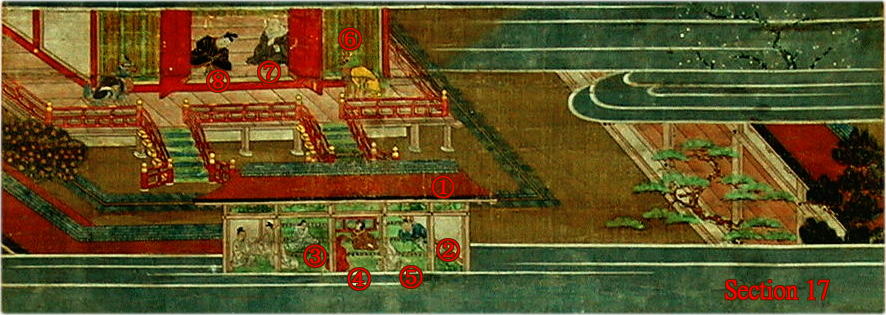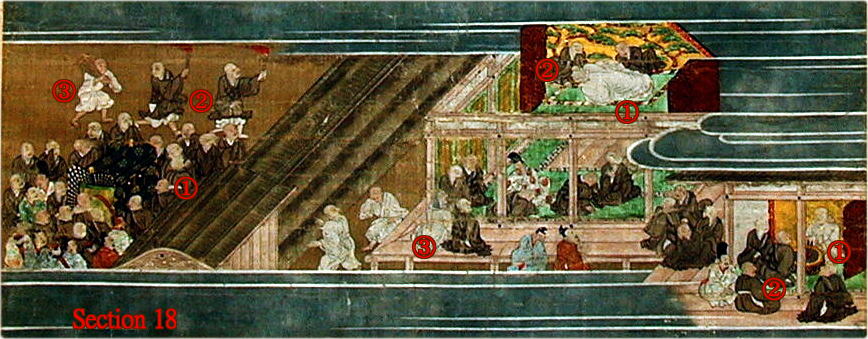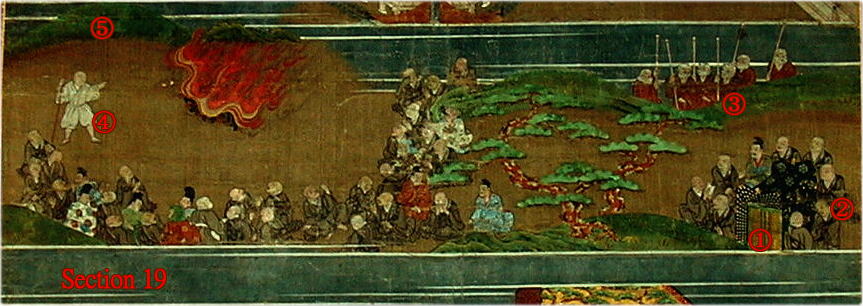An Illustrated Biography of Shinran, the Honganji Shonin
(Honganji Shonin Shinran Denne)
Compiled by Kakunyo
Introduction, translation and notes
by Zuio H. Inagaki
Go to Index to Shinran denne;Sukhavati-Index; General Index
12
Leaving behind the boundary of the Kanto
district, Shonin took the path to the Flower
Castle of Kyoto. On the way, he came to the
perilous mountain pass of Hikone in the dusk.
Following the steps of wayfarers for a long
while, he at last found a house. The night
was far advanced and day was about to break.
The moon had already sunk behind the edge
of the mountain.
Shonin went up to the house and knocked at
the door. A very old man, dressed in magnificent
attire, quickly came out and said, "According
to the custom of this area, which is near
the [Hakone] Shrine, those engaged in service
of kami spend all night in merrymaking. While enjoying
evening festivities with others, I fell asleep
without noticing. Unaware of whether I was
dreaming or not, I had a vision, in which
the Gongen God appeared and said to me, "A
special guest whom I deeply revere will soon
be coming this way. Be sure that due respect
and courtesy be paid to him, and entertain
him with utmost care."
Before I fully awoke from the inspired dream,
you suddenly appeared before me. How could
you be an ordinary person? The God's message
is indubitable. The divine working commands
our deepest reverence."
So saying, the old man respectfully ushered
Shonin in, and prepared sumptuous food of
delicate flavor for him.

Section 16 Shonin and Gongen gods.
<Right> Hakone Gongen
1. Shonin at the age of 62 greeted by the
priest of the Hakone Gongen shrine.
2. Ren'i-bo.
3. Sainen-bo.
<Left> Kumano Gongen
1. Shonin's hermitage in Kyoto.
2. Shonin at the age of 68.
3. Heitaro, aged 44, asking Shonin whether
he should perform his assignment to
visit the Kumano Gongen in the light of his
faith in Jodo Shinshu.
4. Ren'i-bo.
13
After returning home to Kyoto, Shonin reflected
upon bygone days; the years past were like
a dream or an illusion. His old abode in
the capital was hardly recognizable. Shonin
moved from one place to another, until he
found the Gojo Nishi-no-toin area. Finding
it to his taste, he lived there for some
time. His disciples who had personally received
his teaching face to face yearned for the
past days of close association with Shonin,
and came a long way to flock at his door.
There was among them a man named Heitaro
of Obu Village in Nakanosai County in Hitachi
Province. He faithfully upheld Shonin's teaching
with singleness of heart.
One day, his public duty obliged Heitaro
to make a pilgrimage to Kumano Shrine. In
order to seek Shonin's advice, he called
on him. Shonin said:
"The sacred teachings are manifold.
If properly applied to the right persons,
they bring great benefit. Now in the period
of Decadent Dharma, however, the practices
in the Path of Sages cannot be accomplished.
[To quote Tao-ch'o,] 'In the present period
of Decadent Dharma, even if millions of people
set out performing practices, not a single
person attains emancipation.'Also, 'Only
the Pure Land Path is passable for us.' These
are clear testimonial passages from scriptures,
and are the Tathagata's Golden Words.
Concerning the true teaching of the Pure
Land Way, I deeply appreciate the patriarchs
of the three countries(1) for developing this teaching. Hence, what
I, Gutoku, recommend is not my own idea.
It should be noted that 'single-hearted mindfulness'
is the essence of the way of birth in the
Pure Land and the core of this school. Although
the three sutras(2) have both implicit and explicit aspects,
they all clarify this either in clear terms
or by implication. In the Larger Sutra, in the section on the three groups of aspirants,(3) single-hearted mindfulness is recommended,
and in the section on transmission of the
teaching(4) this is transmitted to Maitreya. In the Contemplation Sutra's section on the nine grades of aspirants,
the Three Minds(5) are presented, and they are transmitted
to Ananda. The One Mind in the Amida Sutra is testified to by many Buddhas.(6) The Discourse-master [Vasubandhu] sets forth
One Mind,(7) and the Master [Shan-tao] uses the term
'single-hearted (practice of the Nembutsu.'(8)
The original state of (the God enshrined
in) the Shojoden Hall(9) is the Lord Preacher under discussion.(10) Out of deep compassion to establish ties
with sentient beings, he has manifested his
incarnation (as Kumano Gongen) by concealing
his original majestic body. His intention
in leaving his incarnated body as such is
to lead beings who have close ties with Amida
to the ocean-like Primal Vow.
For this reason, those who entrust themselves
to the Vow of the original Buddhahood and
recite the Nembutsu with singleness of heart
may very well perform public duties and,
by the order of the manor lord, make a pilgrimage
to its sacred site (in Kumano) and pay homage
to the God in the shrine; you do not do this
of your own accord. While entertaining vain
and deceitful thoughts, you should not show
the appearance of being wise, good and diligent
to the deity in incarnation. Leave yourself
to the Vow of the original Buddha. How grateful
I am! Your visit does not mean despising
the deity; it is most unlikely that the deity
will stare at you with an angry look."
Thereupon, Heitaro visited Kumano. He did
not observe the prescribed manner concerning
the pilgrimage. He did not hide the feelings
of an ordinary person who is eternally sinking
in birth-and-death, nor did he purify his
defiled body. Instead, he kept adoring the
Primal Vow, whether walking, standing, sitting
or lying down. Even for a short while, he
did not disobey the Master's teaching.
He reached Kumano without any incident. On
that night, Heitaro had a vision in a dream:
the door of the shrine was opened and a layman
in proper ceremonial dress and hat came in
and said to Heitaro, "Why have you come
here in such a defiled and impure state,
unafraid of the deity?"
At that moment, Shonin suddenly appeared
before him and said, "He practices the
Nembutsu in accordance with Zenshin's instructions."
Thereupon, the layman held up his scepter
in the proper way and bowed deeply to show
his respect to Shonin, without saying a word.
Then Heitaro awoke. He was struck with unspeakable
wonder.
On his way home, Heitaro paid a visit to
Shonin and told him what had happened. In
reply Shonin said, "That was good."
This was also an inconceivable thing.
Notes:
1. India, China and Japan.
2. The three Pure Land sutras are the Larger Sutra, the Contemplation Sutra and the Amida Sutra (or the Smaller Sutra).
3. See chapters 23-25 of the Larger Sutra (Amida Net: dai-22-25.htm).
4. See chapter 47 of the Larger Sutra (Amida Net: dai-41-48 .htm).
5. The Three Minds are sincere faith, deep
faith, and the faith that seeks birth in
the Pure Land by transferring one's merit;
see chapter 22 (Amida Net: tai-22-24.htm).
6. See chapters 5ff. of the Amida Sutra (Amida Net: ami-4-5.htm).
7. In his Verses of Aspiration for Birth, Vasubandhu professes "With singleness
of mind, I take refuge in the Tathagata of
Unhindered Light Shining throughout the Ten
Quarters." Shinran interprets 'singleness
of mind' as 'One Mind' which is essentially
the same as 'Three Minds' of the Eighteenth
Vow and is the Faith of the Other-Power.
8. Refers to Shan-tao's explanation in his
Commentary on the Contemplation Sutra, in the section on the Non-meditative Good:
"Although I have above explained the
benefit of both the Meditative and Non-meditative
Good, from the viewpoint of the intent of
the Buddha's Primal Vow, what is implied
(in the sutra) is that sentient beings should
single-heartedly recite Amida Buddha's Name.
9. Of all the twelve shrines of Kumano Gongen,
Shojoden is the principal one.
10. Refers here to Amida.

Section 17 Heitaro's visit to the Kamano Gongen
1. The shrine office in the Kumano
Gongen.
2. Heitaro having a vision of Shonin in the
dream.
3. Satake Suekata.
4. Suekata's wife.
5. Kuruhon-bo, a yamabushi leader.
6. The main hall, called Shojoden, which
appeared in the dream.
7. Shonin talking to a lay-member of the
shrine.
8. The lay-member of the shrine.
14
Towards the end of the eleventh month in
the second year of Kocho [the year of water/dog]
(1262), Shonin became ill. From that time
on, he did not talk about secular matters,
but only spoke in deep appreciation of the
Buddha's benevolence. He uttered no other
words but solely recited the Nembutsu without
ceasing.
On the eighth day, at the hour of the horse,(1) of the same month, lying on his right side,
facing west and keeping his head to the north,(2) Shonin breathed his last breath while saying
the Nembutsu. He was ninety years of age.
His hermitage was in Kyoto, south of Oshi-koji
street and east of Madeno-koji alley.(3) The coffin was carried eastwards over the
Kamo River to the Ennin-ji, south of Toribeno
at the western foot of Higashiyama, where
the funeral was conducted. His remains were
collected and deposited at Otani, north of
Toribeno at the foot of Higashiyama. All
his disciples and followers, both young and
old, who witnessed his last moment, remembering
fondly the happy bygone days when he was
alive, and now grieving over his passing,
cried bitterly with deep yearning.
Notes:
1. The hour of the horse corresponds to midday.
It has been traditionally established in
Japan that the time of the death of an eminent
monk is the hour of the horse even if he
dies at a different time.
2. This is the posture taken by Shakyamuni
when he passed into Nirvana. So it has become
the standard posture of dying Buddhists.
Why did he keep his head to the north? According
to one theory, it is because he wanted to
show that his teaching would spread to the
north. Why did he lie on his right side?
According to one theory, it is because he
wanted to follow the posture of dying taken
by the king of lions; it was also believed
that a deity dies while lying face up, a
devil dies with its face downward, and a
greedy man dies while lying on his left side.
3. The location of this place is believed
to be Sanjo tomikoji in the Ukyo part of
Kyoto, where there was a Tendai temple called
Zenpo-in. Shinran's younger brother, Jinnu,
was the head priest of this temple, where
Shinran spent his last years and died. At
this place (i.e., Yamanouchi, Saiin, Ukyoku,
Kyoto), Honganji built its Branch Temple,
Sumino-bo, in 1857.

Section 18 Shonin's illness and death.
<Right> Shonin becoming ill at his
younger brother's (Jin'u) temple.
1. Shonin meeting his disciples.
2. Kenchi, Dosho of Masukata [Shonin's fifth
child], Ren'i and others.
<Middle> Shonin at his deathbed at
the age of 90.
1. Shonin's passing.
2. Senshin-bo.
3. Probably, Shonin's daughter, Kakushin-ni.
<Left> To the crematorium,
1. Shonin's disciples carrying the coffin.
2. The priests leading the mourners.
3. The man in charge of cremation.

Section 19 Cremation at the Enninji Temple in Hiyashiyama.
1. The palanquin that carried the coffin.
2. The mourners.
3. The guardian monks.
4. The man who performed the cremation.
5. Toribeno at the foot of Mt. Higashiyama.
15
In the winter of the ninth year of Bun'ei
(1272), Shonin's tomb at Otani, north of
Toribeno at the western foot of Higashiyama,
was moved westwards and placed north of Yoshinizu.
His remains were redeposited, and a mausoleum
was constructed where his image was enshrined.
From that time on, the teaching transmitted
by Shonin grew more and more, and his doctrine
was more widely accepted than when he was
alive. Now his followers fill every province
and county, and those who belong to this
school are scattered everywhere in large
numbers. Both priests and laypeople, young
and old, who deeply revere his teaching and
are diligently committed to repaying their
indebtedness to Shonin, each make a pilgrimage
to the mausoleum every year.
Many miraculous stories were told about Shonin,
but it is impossible to relate them all.
I have presented only a selected few.

Section 20 Construction of Otani Mausoleum.
1. Shonin's statue in the Mausoleum.
2. Part of the roof of the worshiping hall.
3. The Southern Hall.
4. The Northern Hall.
5. A red plumb tree.
6. A white plumb tree.
7. A caretaker.
 Go to Index to Shinran denne;Sukhavati-Index; General Index
Go to Index to Shinran denne;Sukhavati-Index; General Index





